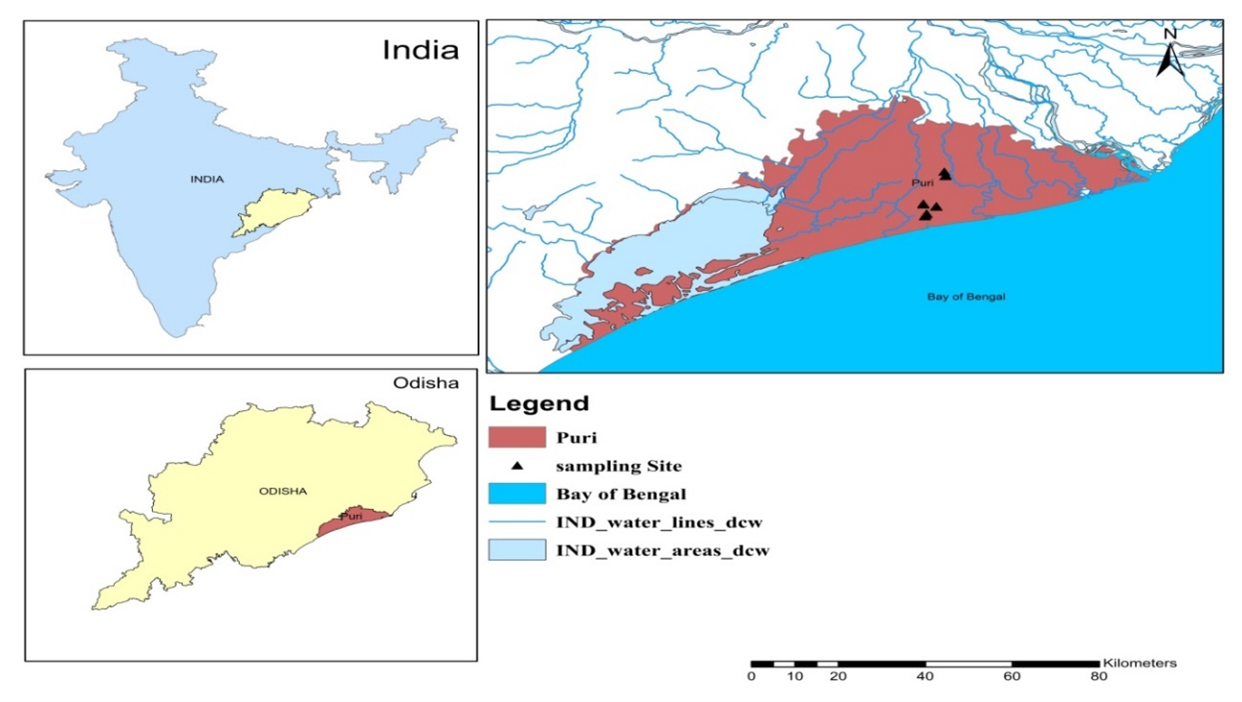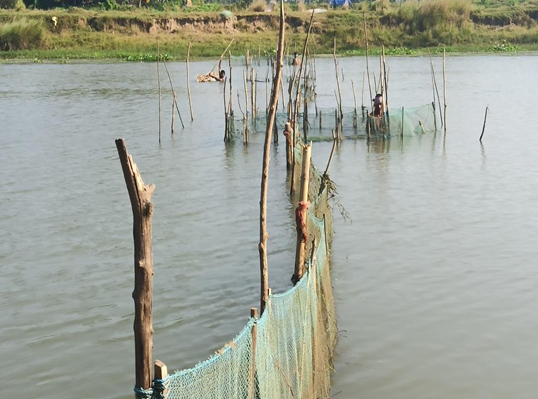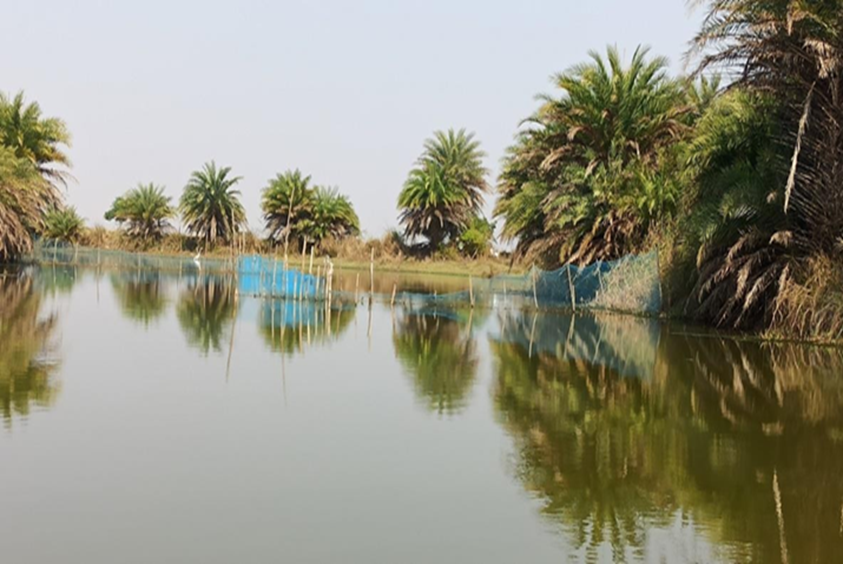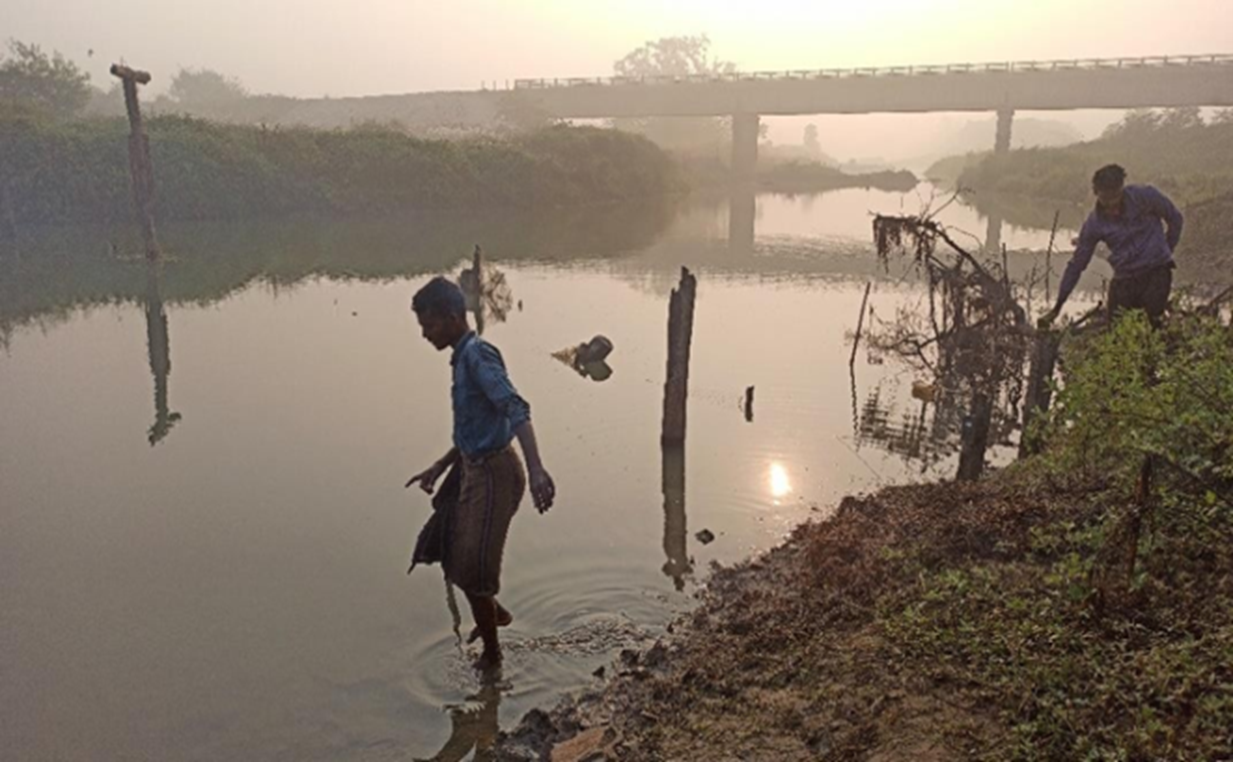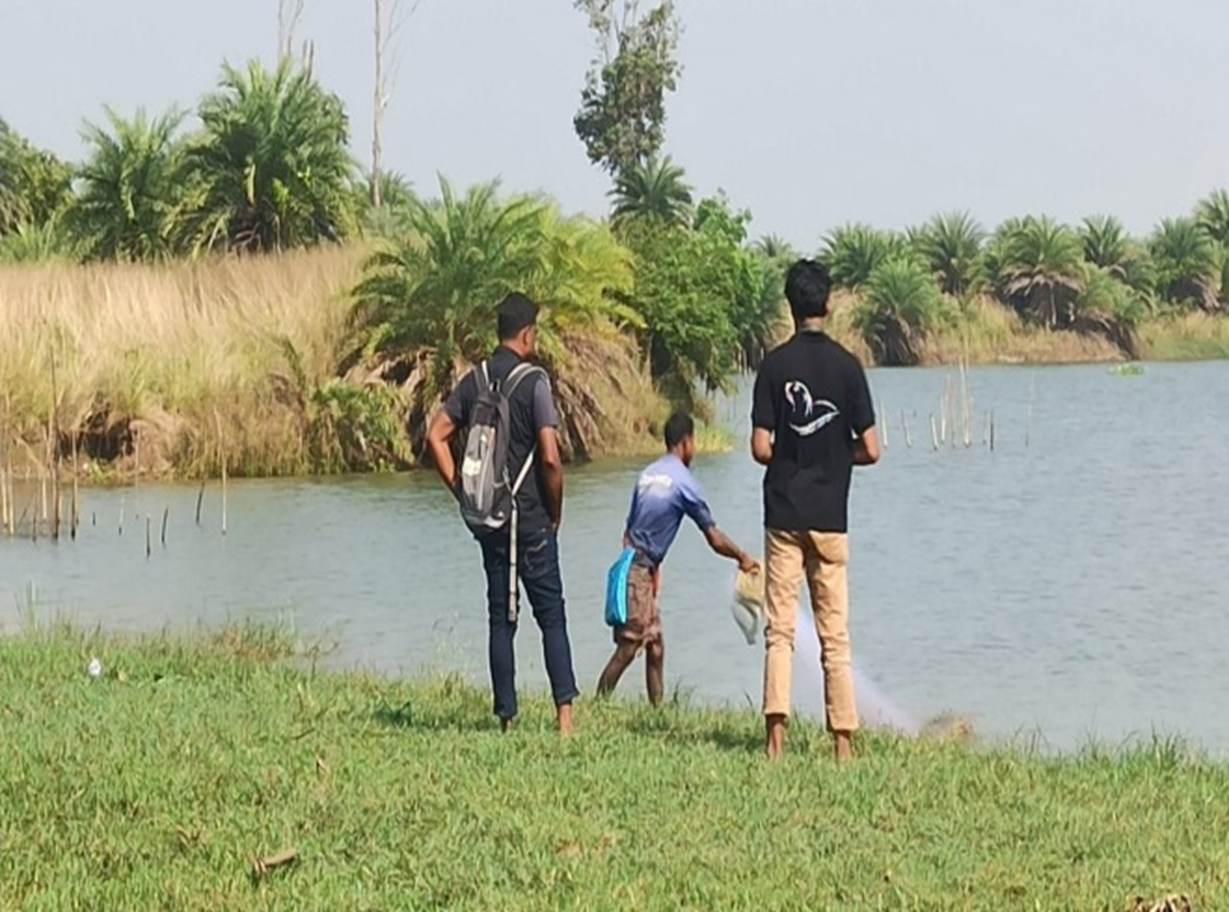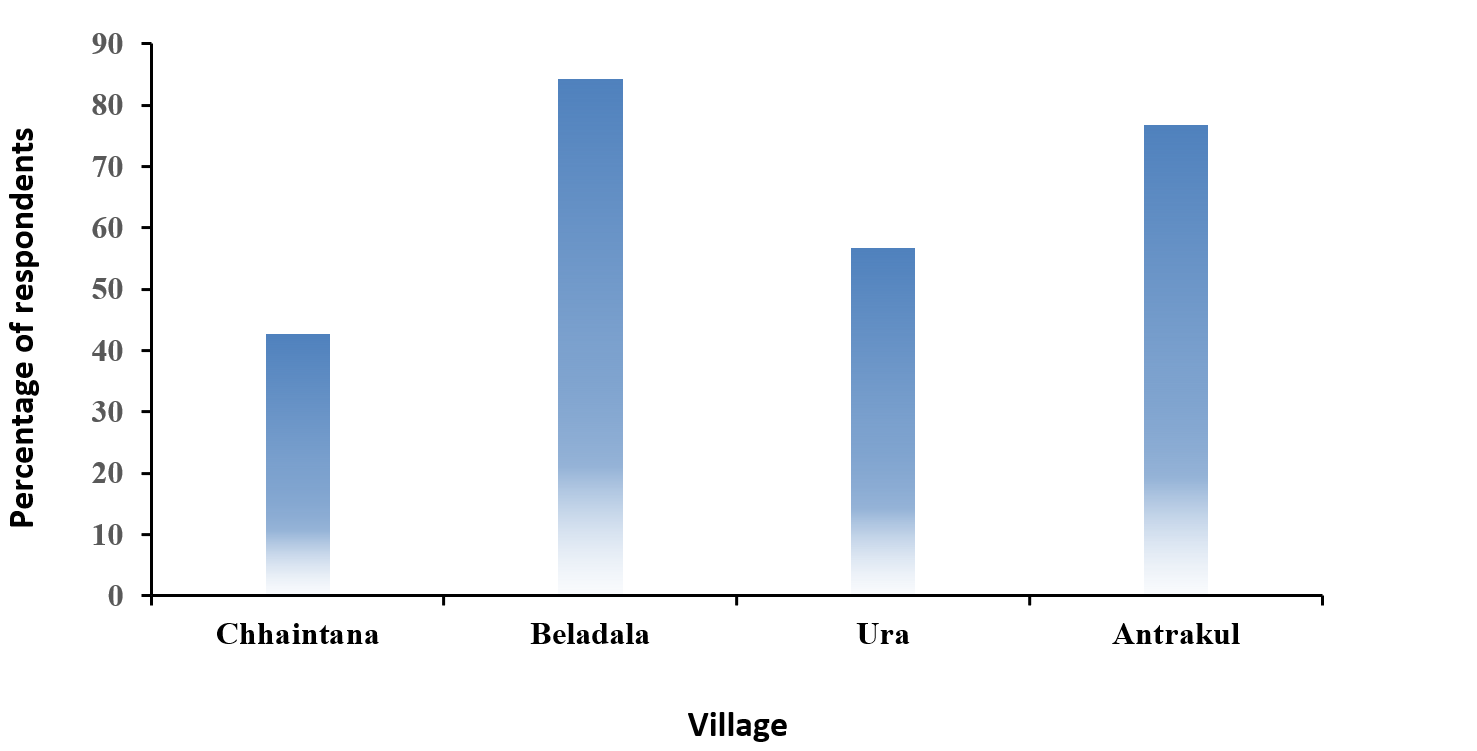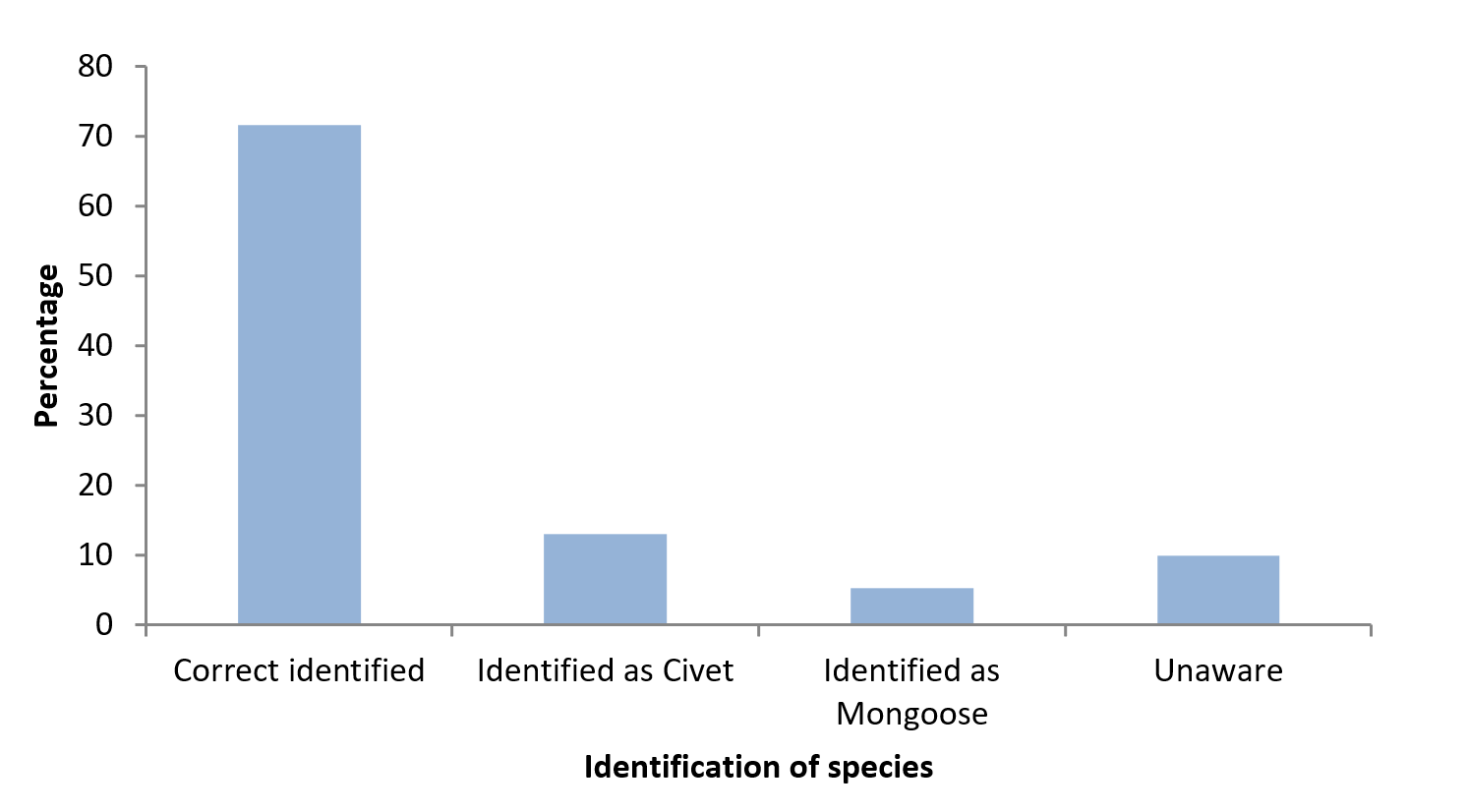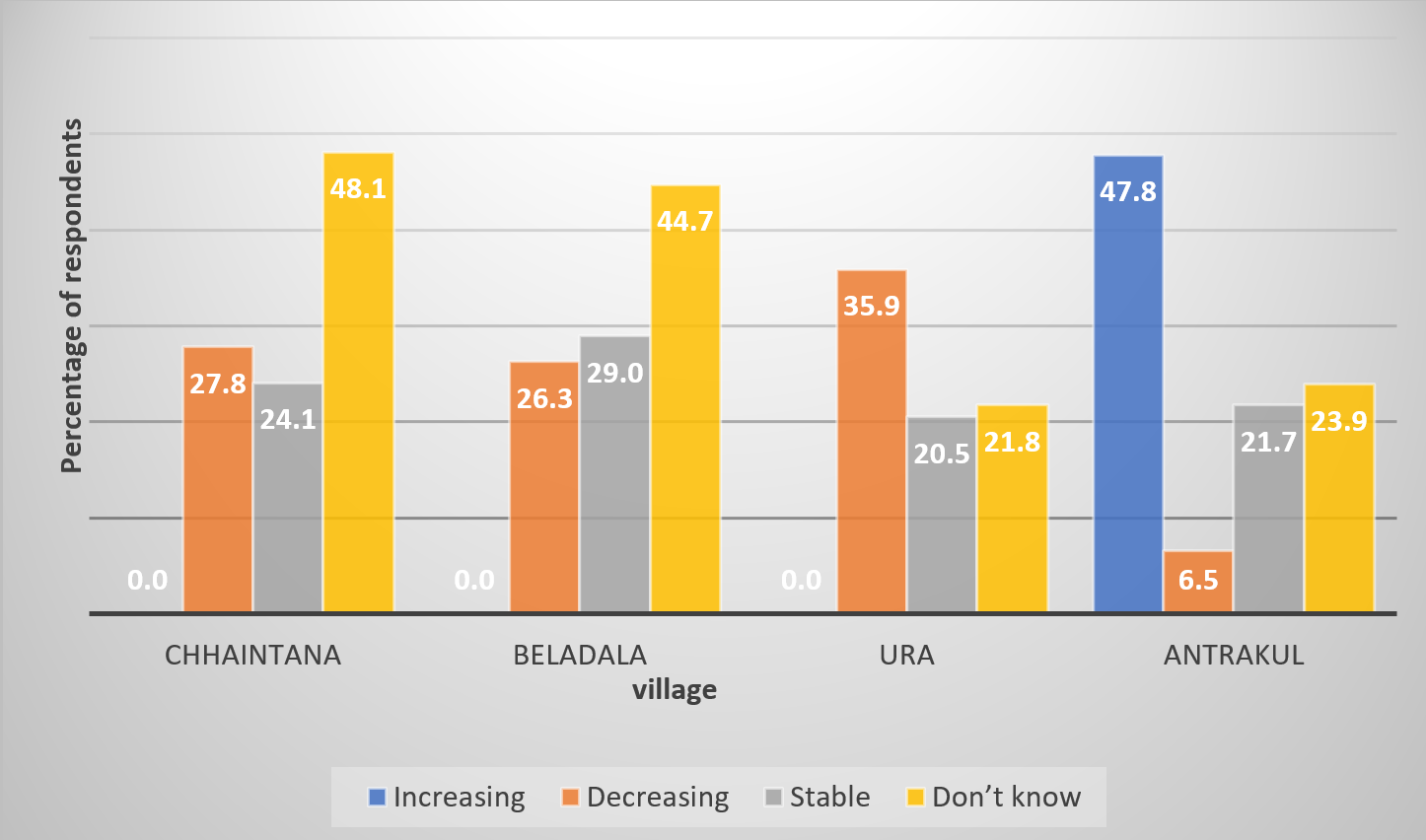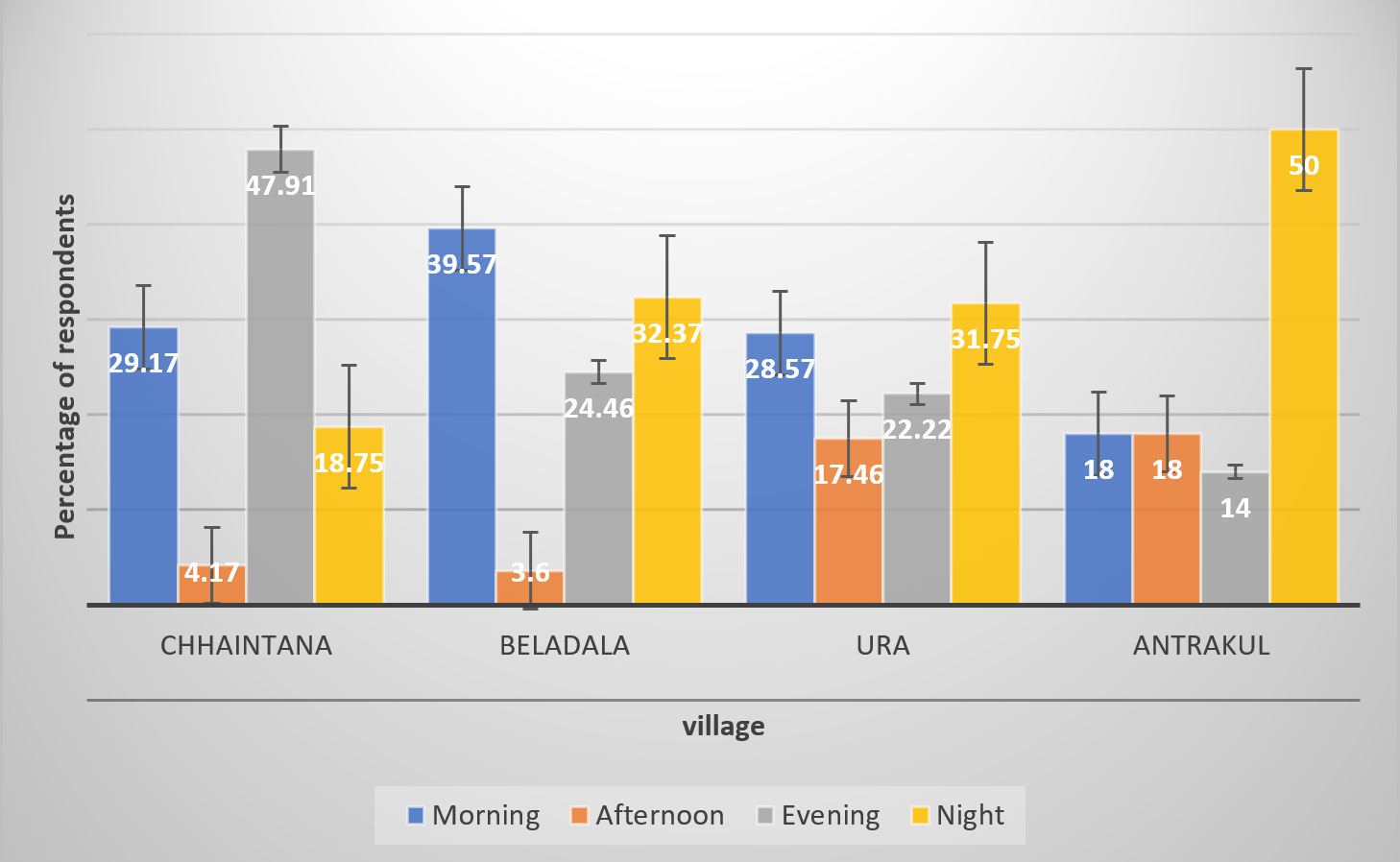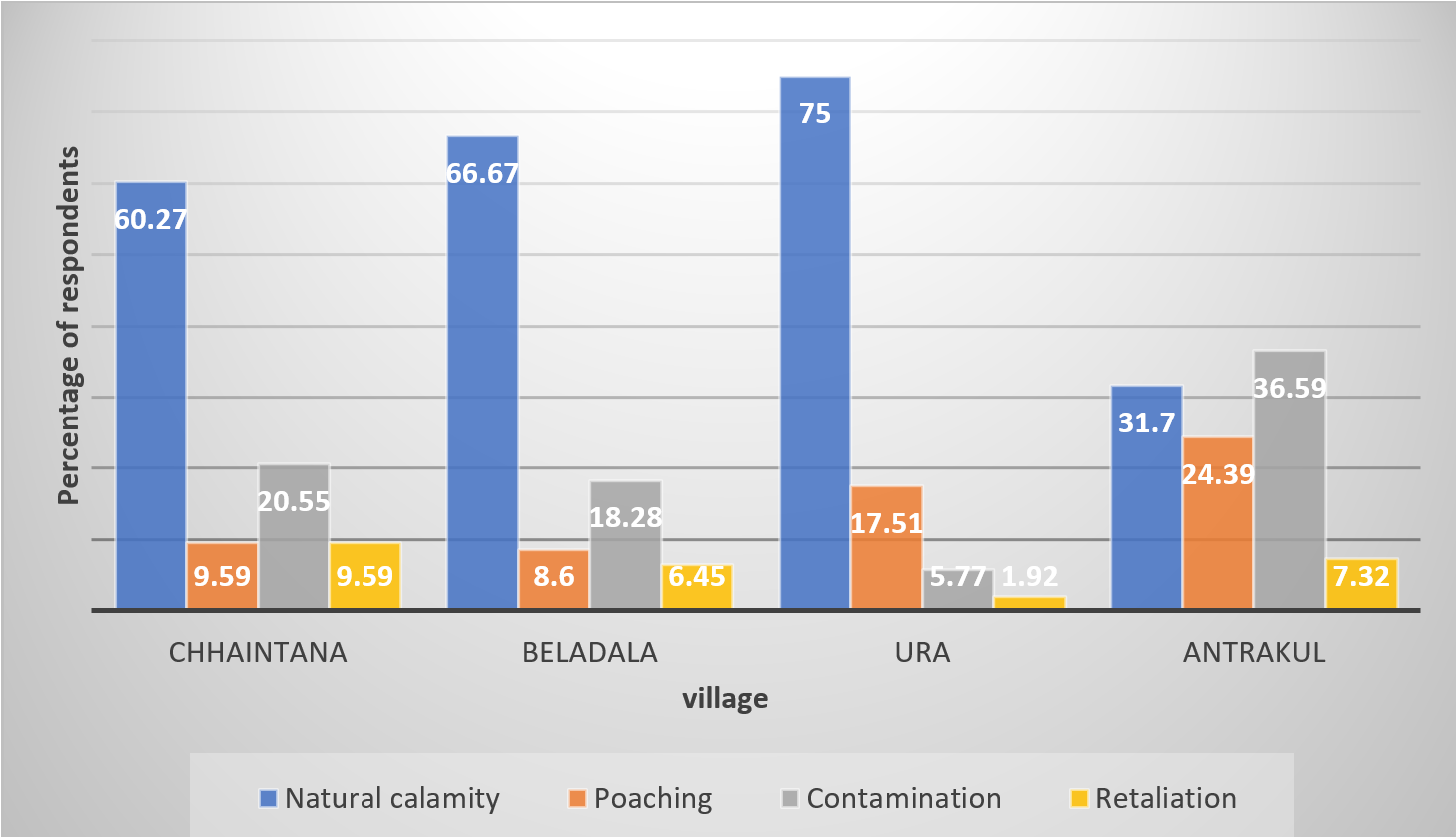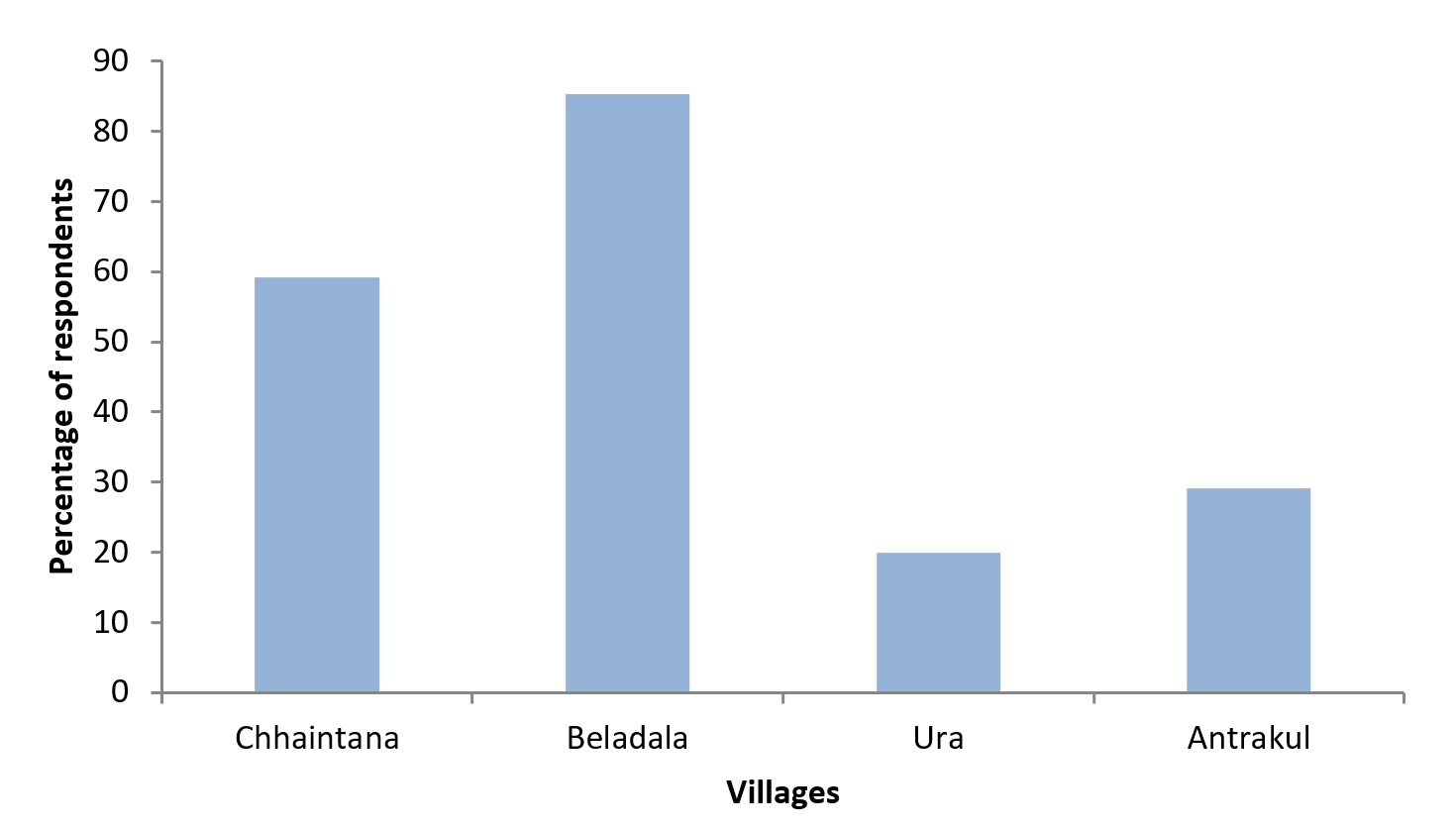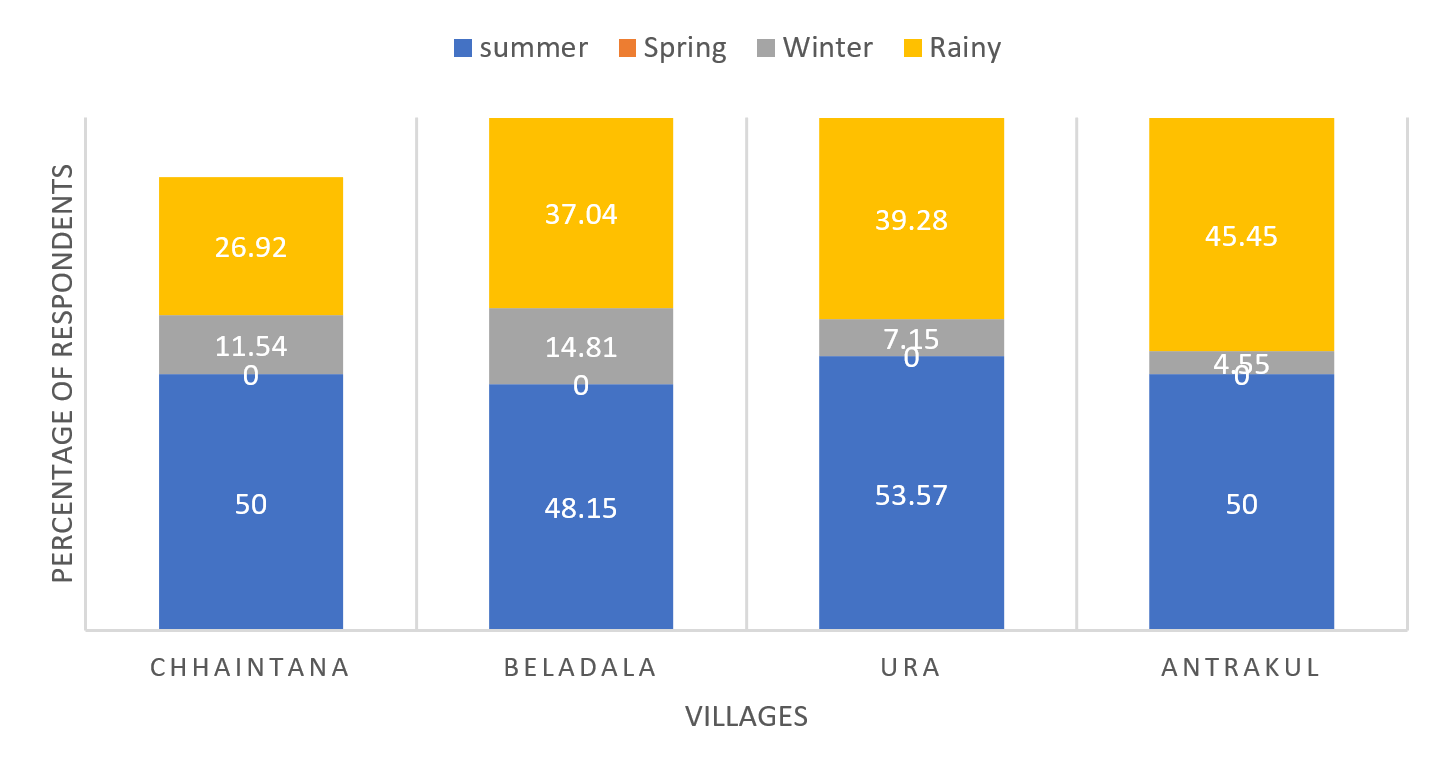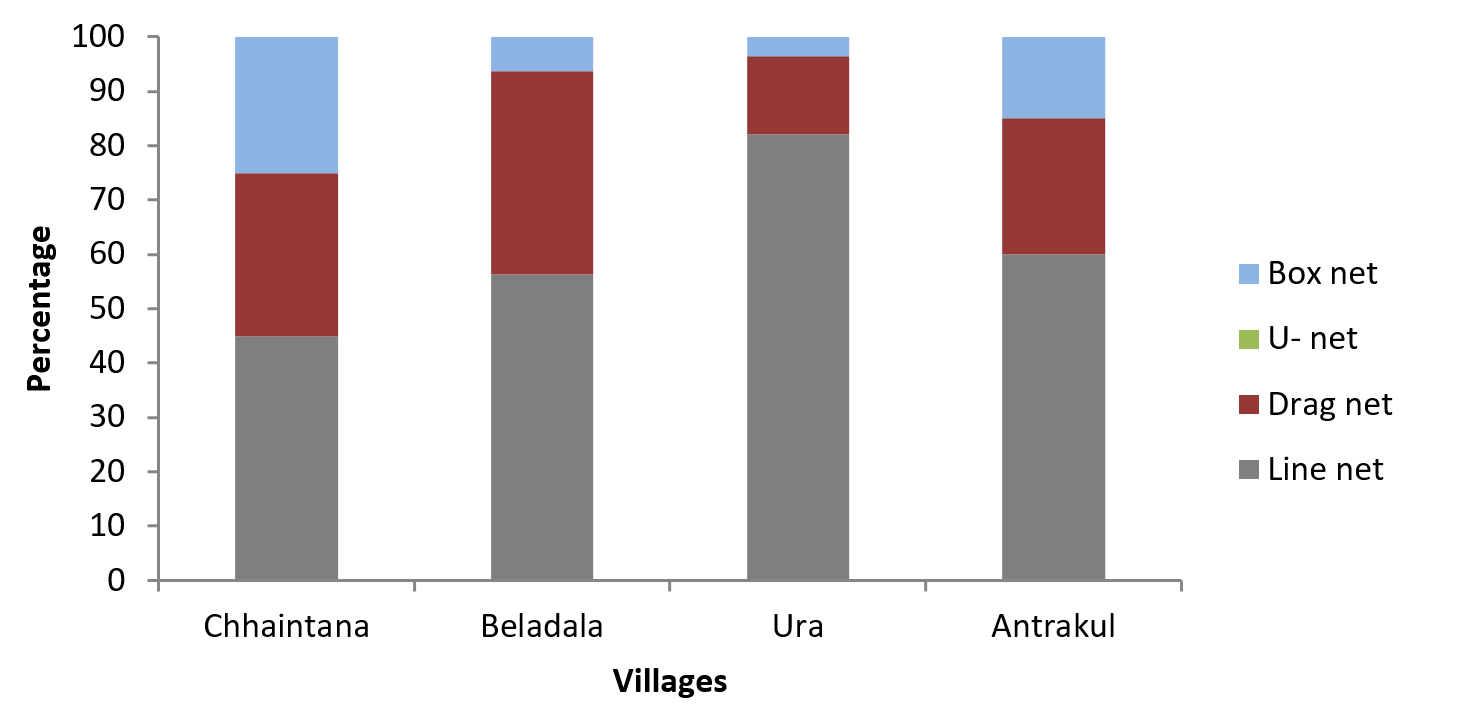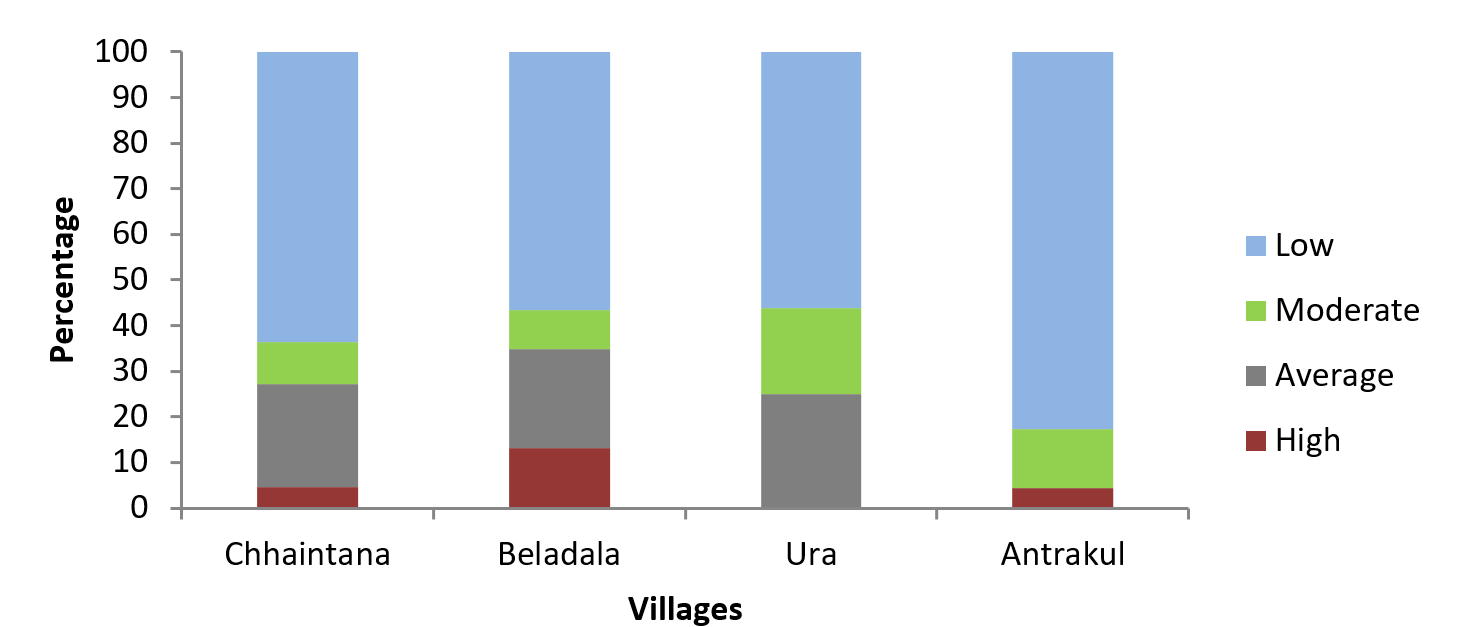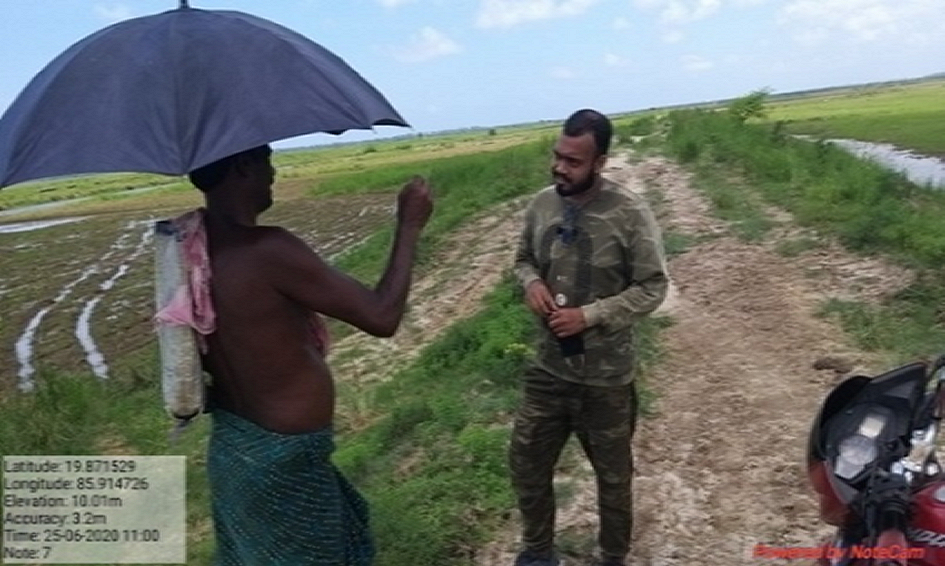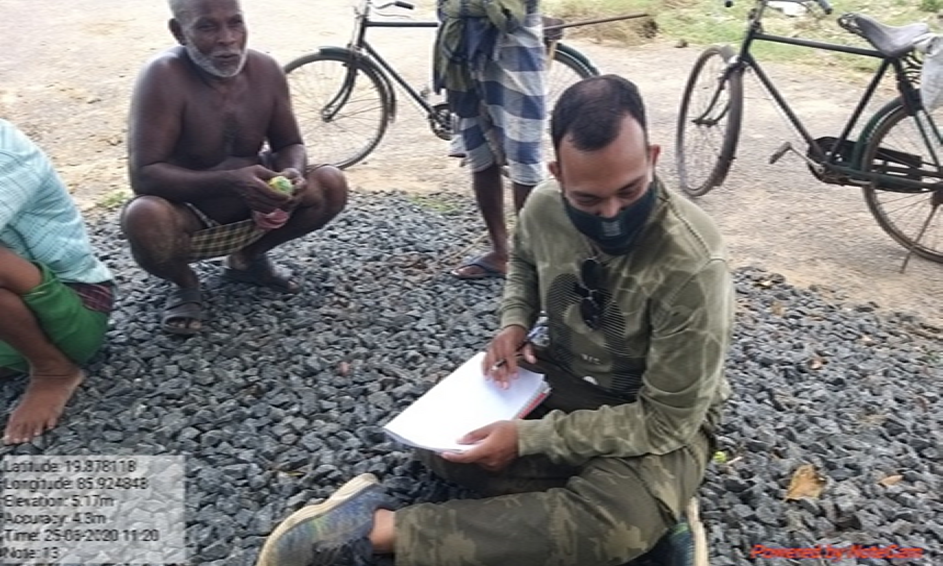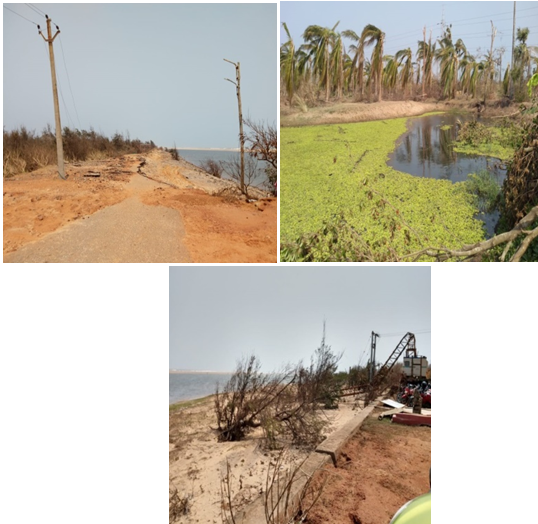IUCN/SSC Otter Specialist Group Bulletin

©IUCN/SCC Otter Specialist Group
Volume 39 Issue 4 (November 2022)
Citation: Pandey, S., Kotak, B.H., Samal, A., Mahapatra, R.P., Fullonton, S. and Jena, K.K. (2022). Assessing Human Dimension in Conservation of Smooth-Coated Otters (Lutrogale perspicillata) in Nuanai River, Puri, Odisha, India. IUCN Otter Spec. Group Bull. 39 (4): 202 - 222
Assessing Human Dimension in Conservation of Smooth-Coated Otters (Lutrogale perspicillata) in Nuanai River, Puri, Odisha, India
Shreya Pandey1, Bhavisha Haresh Kotak2, Aurobindo Samal1, 3*, Rudra Prasanna Mahapatra4, Swarup Fullonton1, and Kalinga Keshari Jena3
1Amity Institute of Forestry and Wildlife, Amity University, Noida, Uttar Pradesh – 201301, India
2Parul University, Waghodiya, Vadodara, Gujurat – 397160, India
3Earth Crusaders Organisation (ECO), Bhubaneswar, Odisha – 751019, India
4Wildlife Trust of India, Bhubaneswar, Odisha – 751013, India
*Corresponding Author Email: aurobindo.cse@gmail.com
(Received 29th January 2022, accepted 25th June 2022)
Abstract: Mammals that use inland and coastal waters interact with people regularly, as they share similar habitats and resources. The Smooth-Coated Otter is an apex predator in the aquatic ecosystem that frequently interacts with local communities. When Cyclone FANI hit Balukhand Wildlife Sanctuary, which is close to the Eco-sensitive Nuanai area, in May 2019, this was one of the victim species witnessing a catastrophic population loss in Puri, Odisha. This is Odisha’s first community-based conservation project. We conducted a semi-structured interview to examine people's perceptions and attitudes regarding the species, as well as to document the population’s dangers. There was a huge threat to the species, but people are more aware now as a result of our research, and there are fewer threats.
Keywords:Smooth-Coated Otters, perception analysis of local community, community awareness, threats to species.
INTRODUCTION
Otters form a distinct group in the Mustelidae family of mammals and are placed in the Lutrinae subfamily (Sivasothi ,1995). Smooth-coated otters are the largest of Asia’s otters (Lutrogale perspicillata), and are semi-aquatic (Nowak, 1991). Smooth-coated otter is known to be one of the least studied species (Hussain and Chaudhry, 1997). Its flattened tail and hairless nose sets it apart from the Eurasian Otter. Identification of this species can be done by a crooked diamond-shaped nose, long body, short muzzle, small eyes, low ears, flattened tail, social (usually found in groups), domed head. The otter’s forelimbs are shorter than the hind limbs; webbed limbs are present allowing it to swim. Small carnivores (Mammalia: Carnivora, bodyweight < 15 kg) make up about 70% of the 286 species of carnivores perceived right now in the Balukhand Wildlife Sanctuary (Wozencraft, 2005). Occupying the apex position in the trophic level, with a prominent population in this area, Smooth-Coated Otters are one of the first species to disappear when the environment is modified or polluted (Foster-Turley et al., 1990; Parera, 1996).
Puri, Odisha has a long history of natural disasters, mainly due to the large number of cyclonic depressions that form each year in the Bay of Bengal. This sub-basin is very active and produced one of the deadliest tornadoes of all time. Tropical cyclones form during the months of March to June and October to December with a peak in May and November. This has become a common scenario where the natural habitat of many animals, the wilderness, is destroyed. This devastation results in the decline of species populations due to habitat loss.
The Smooth-Coated Otter was a victim species facing a severe population decline in Puri in May 2019, when Cyclone FANI struck Balukhand Wildlife Sanctuary, which is near to the Eco-sensitive Nuanai area. Cyclone FANI forced Smooth-Coated Otters to shift their ranges and move towards soft shade or buffer areas closer to human habitats, which subsequently led to otter-human conflict. This study helps in understanding the situation and accounting the main stressors on Smooth-Coated Otters post FANI; this can be further monitored closely to minimize problems of conflict, and design an appropriate restoration plan for the area, taking into account the species’ needs and the concerns of local people. Wildlife management is not limited to the conservation of certain species of flora and fauna: it is about managing an entire ecosystem (de Wulf et al., 1988). When planning conservation actions, the complex ways in which humans affect wildlife and habitat adaptation through direct and indirect actions must be taken into account (Ditchkoff et al., 2006).
Human dimensions in Species Conservation
Human perceptions towards carnivores differ with a number of variables including: gender (Campbell and Alvarado, 2011), age (Morzillo et al., 2010; Campbell and Alvarado, 2011), species (Lescureux and Linnell, 2010; Campbell and Alvarado, 2011), knowledge/education (Morzillo et al., 2010; Lescureux et al., 2011), location (Dar et al., 2009; ; Liu et al., 2011), occupation (Hazzah et al., 2009; Lescureux and Linnell, 2010), frequency of contact (Hazzah et al., 2009; Lescureux and Linnell, 2010; Lescureux et al., 2011; Liu et al., 2011), and religious/belief systems (Hazzah et al., 2009; Liu et al., 2011). This lability in perceptions means that through actions such as environmental education, it is possible to modify human perceptions, which can directly influence human behaviors with positive outcomes such as reducing human wildlife conflicts and promoting the conservation of biodiversity (Dickman, 2010), but see Liu et al., 2011. The increase and expansion of human populations means that biodiversity and species conservation activities are intrinsically associated with the socio-economic context (Marshall et al., 2007; Dickman, 2010). The resolution of human-wildlife conflicts (Dickman, 2010), the success of re-introduction (Morzillo et al., 2010), and the effectiveness of protected areas (Andam et al., 2008) are all dependent on the local context, which includes the perceptions of stakeholders.
Community based conservation is often given meaning at odds with the cultural perspectives of the ‘communities’ that are expected to practice it. The term covers a broad spectrum of management and benefit-sharing arrangements for the involvement in natural resource management of people who are not agents of the state but, by virtue of their location and activities, are critically placed to enhance or degrade the present and future status of natural resources. In its study of community approaches to wildlife management IIED (1994) points out that the concept can be approached in spatial, sociocultural, and economic terms. Economically they can be considered as ‘groupings of people who share interests and control over particular resources’. For rural peoples, for whom the presence of wildlife has important economic implications, wildlife valuations tend to be more instrumental, even where their cultures assign an intrinsic value to wildlife.
Perceptions may range from positive when otters can act as tourist attractions capable of generating revenue, neutral in agricultural landscapes where they have no impact on local economies (Norris and Michalski, 2009), to negative where Otters are perceived as competitors by fisherman (Gómez & Jorgenson, 1999; Recharte et al., 2008), there is often a considerable disparity between the real and perceived impacts of otters (such as net damage and stock consumption) (Gómez and Jorgenson, 1999; Freitas et al., 2007; Recharte et al., 2008; Rosas-Ribeiro et al., 2011; Vaclavikova et al., 2011).
The deficiency of baseline data on its distribution and ecology is another major constraint that hampers the protection of the species in India (Nawab and Gautam, 2008). Once commonly found throughout its distribution range, the smooth-coated otter started disappearing from a number of its known distribution locations.
STUDY AREA
This study was carried out between May 2020 and February 2021 along the entire ecosensitive zone of Balukhand Wildlife Sanctuary and one of its major tributary the river Nuanai catchment, along the villages which form the part of the study area (Fig 1). This area lies between 20 m and 100 m above sea level.
River Nuanai is one of the major rivers of Odisha, located near the Balukhand - Konark wildlife sanctuary. It flows through the district of Puri. This manmade sanctuary is home to numbers of wild flora and fauna. Just like any other river here, the Nuanai is both revered, and highly modified for human use. The river flows through plantations, forest and paddy fields, and also through highly cultivated areas, since agricultural fields flank both sides of the river. Keeping otter-human conflicts and density of riparian cover in mind, we chose four places as our project sites: Chainntana, Beladala, Ura and Antarakul villages in Gop.
These areas are highly modified human landscapes and are infamous for poaching and human-animal conflicts. As most of the population depend upon this river, otter-human conflict is very likely here. Competition for fish is the major issue as the Smooth-Coated Otter looks for easy sources of prey, and in turn damage nets and gets into conflict with fishermen. Intensive fishing, sand mining and numerous dams for irrigation causes habitat fragmentation and increase anthropogenic pressure. As both side of the river flank agricultural fields, this water body is prone to both accidental and intentional pesticide contamination.
Village 1. Chhaintana: (GPS coordinates: Lat – 19.880112, Lon – 85.924844)
There is a good amount of riparian cover on the banks, and holts can be seen easily here. There are mainly two types of community here: fishermen and farmers. The landform change here was unusual enough choose as a project sites (Fig 2).
Village 2. Beladala: (GPS coordinates: Lat – 19.852205, Lon – 85.90068)
This is a place where the river Nuanai is quite shallow. Here, one part of the river flanks agricultural fields, plantations, and paddy patches whereas the other side is a residential village. Most of the people are farmers here and the fishermen community is very small though the farmers occasionally fish here as well. There is no sign of overfishing or contamination at a first glance, but otter-human conflict prevails here too. The whole village consists of several branches of one family, who are really supportive of each other. The salinity of the waterbody at this place varies and that is why we chose to include this place in our list of project sites (Figure 3).
Village 3. Ura: (GPS coordinates: Lat – 19.983282, Lon – 85.93503)
This is the place where this river is at its deepest (Fig 4). The fishing community is very active here as the fish catch is easy. Abandoned holts can be seen here with no signs of recent activity. We wanted certainty regarding the otter population here and that is why we decided to list this place as one of our project sites. Smaller carnivores like jackals and scavengers like hyaena can be seen roaming on the banks of the river.
Village 4. Antarakul: (GPS coordinates: Lat – 19.965642, Lon – 85.943455)
A branch river of Nuanai, the Dhanua, flows through this region (Fig 5). There are no agricultural fields here on either side of the riverbank. The community here is mainly fishermen and livestock farmers. The habitat contains both rocky river banks to rest and marshy areas to forage and otters may roam freely because of dense riparian cover. The waterbody here remains fresh throughout the year and that is why we selected this as one of our study sites. The local community is not so welcoming to foreigners. Pesticide contamination is taking place here, along with snaring and poaching of several species.
Nuanai Eco-Sensitive Zone
This is a buffer area outside the Balukhand wildlife sanctuary and is highly eco-sensitive; it suffered from huge damage during the cyclonic storm. This area falls between the villages and the epicenter where the cyclone hit the landmass. Fig 6.
METHODS
A sampling framework comprising of different villages was initially developed. The first stage, a rapid assessment of the study area, was done in order to obtain overall information from the villages. Families were visited and their dependency on forests, and interests and attitudes towardst otter conservation were studied.
The secondary data was obtained from the questionnaire survey, which was divided into two groups. First was the local (farming) community and second the fishermen community.
This survey was done in the form of a semi-structured interview with a set of questions asked to 300 male respondents both of the local community (n=150) and fishermen community (n=150), on average above the age of 30 (as the females did not came out of their homes, and their interactions were restricted), and some questions were only asked of the fishermen community (See Annex).
We tested our hypothesis that the “People are not aware of otters and its ecological significance” through Analysis of Variance (ANOVA) (Excel 2016). It is used to test the equality of two or more population (or treatment) means by examining the variances of samples that are taken. ANOVA is based on comparing the variance (or variation) between the data samples to variation within each particular sample. If the between variation is much larger than the within variation, the means of different samples will not be equal. If the between and within variations are approximately the same size, then there is no significant difference between sample means. Since ANOVA is a parametric test, we first analysed the normality of the data.
We performed the Chi-Square test to assess which among the four major factors are responsible for the decline in otter population in the study area. The purpose of the test is to evaluate how likely the observed frequencies would be, assuming the null hypothesis is true. After the study and completion of the project, we conducted a post- perception study and compared the retaliatory killing before and after the study through paired t-test. A paired t-test is used when we are interested in the difference between two variables for the same subject, often the two variables are separated by time as in this case.
The threats were assessed based on direct and indirect evidence collected through sign surveys conducted in the study area between Mar 2020 and Jan 2021. Certain rapport building practices were implemented in communities residing across study area.
The questionnaire was prepared which contained closed-ended questions including queries regarding otters, their behaviors, habitat, morphology, sightings, human-otter conflicts, possible threats, myths, and recommendations of conservation measures to be asked; each question lead to several other multilevel aspects and other questions.
Based on observation and findings during the questionnaire survey, and evaluation of trading records, different educational awareness programs were conducted in public places and gathering places.
Perception study
People perception study is the process of documenting, analyzing, and summarizing local people’s perspectives of a species or of conservation in general. During this study, questions were formed keeping the social and cognitive behavior of a local community in mind. This study is of immense importance during conservation projects, especially projects based at revenue areas where human-animal interaction is a must. Knowing the perception of the local community and fishermen is vital. Since monitoring otter behavior is very complex and lengthy, any help obtained from the people perception study is very useful and valid.
People were aware of otter presence in some areas. They were able to identify otters from their morphology. We found out how fishermen retaliate after otters have destroyed the fishing nets. Some of the fishing gear commonly used in this area are clutch wires, trap nets, line nets, box nets etc. We also gathered some sighting information, as people saw otters during dawn or dusk. We noted everything, and it helped us to create awareness among local communities more specifically and it also was helpful during otter-human conflict mitigation.
Rapport building
A relationship involving mutual respect and understanding among all parties who possess each other’s best interests in mind is known as rapport. Building a trusting relationship between two or more people and creating rapport between them is known as rapport building. During this process, conservationists impart their knowledge to the local communities, encouraging them to carry forward the executed mitigation measures even after the completion of the project. The process includes
- Identifying common grounds that both parties can agree on, making clear intentions, and explaining to people the importance of otter conservation in their locality.
- Understanding and trustworthy body language help garner support from the locals.
Because of rapport building with the local communities, they participated in several conservation measures during this project. Apart from several surveys conducted by our team, we depended upon the information being provided by the locals to trace otters and identify threats towards them. We were also able to locate conflict-prone areas where we were able to assess threats with support received from the locals. Rapport building with the fishermen community helped us during our human-otter conflict mitigation segment under which we compensated suffering fishermen with new fishing nets.
Perception analysis of both Local and fishermen community:
Data was found to be normally distributed. Based on ANOVA (df =3), we accepted the null hypothesis (P=0.74 that people from the four villages are aware of the otter and its ecological importance and the sample mean of the four villages population was same and there was no significant difference observed.
- Awareness and Species Identification
In the perception study of 300 persons from 4 villages, we found that 84% of the people from Beladala had seen otters, compared to 77% of the people from Antrakul, 57% of the people from Ura and only 43% of the people from Chhaintana. (Fig. 7).
We found that among the 300 men, 71.67% could correctly identified otters, while 13% of them identified otters as civet, 5.34% people identified them as mongoose, and 10% were unaware of otters (Fig. 8.). People were not able to distinguish between the otter species.
- Population Trend
According to this study, people from Antrakul (47.82%) believed that the otter population is increasing. People from Ura (36%) believed that the otter population is decreasing. Most people from Beladala (45%) and Chhaintana (48.13%) are unaware of the otter population (Fig. 9). It can be seen declining or uncertain depending on the answers given by the people.
- Activity Pattern
According to respondents, in Chhaintana (47.91%) otters were found to be active during evening, while in Beladala (39.8%) the otters were found to be active during morning. The people from Ura (31.75%) and Antrakul (50%) found otters to be active at night (Fig. 10).
- Major Factors for Population Decline and Species Ecological Value
We suggested some major possible threats, and local people had no other opinion or suggestions. Most people from the villages Beladala (66.67%), Ura (75%), and Chhaintana (60.27%) believed the main reason for otter population decline was natural calamity. People from Antrakul considered that natural calamity and contamination were the reason for otter population decline (Fig. 11). According to this study, overall, retaliatory killing in all the four regions was considered low at 6.67%. The chi-square statistic is 40.7416. The P-value is <0.00001 and the result is significant at P<0.05.
The results from the chi-square test show that each factor: natural calamity, poaching, contamination, and retaliation, contributes to the depletion of otter populations. When we asked that whether the species was important for the natural environment, we found that a majority of the people from Beladala and Chhaintana found otters to be important for the natural environment, in contrast to those from Antrakul and Ura (Fig. 12). We explained this term “Ecological importance” to people in a very simple manner by asking whether they thought this species is important for nature or not?
Perception Analysis Survey of the Fishing Community Alone: Fish Catch based on Season, Fishing Net Type used and Damage caused by Otters
From the survey of the fishing community (n=150), most fishermen in all four villages thought that the fish catch is highest during summer (48%-53%) compared to rainy season (26%-46%) and winter (4%-15%) (Fig. 13).
The survey shows that most fishermen use line nets in all villages, followed by drag nets and box-nets. Line nets were majorly found damaged by otters (Fig. 14). The entangled prey is being taken by the otter and in doing so they tear apart the net sieve.
According to the survey, a very low percentage of fishermen overall believed that their nets were damaged by the otters. Some people from Chhaintana, Beladala and Ura found their fishing nets damaged by otters (Fig. 15).
Post-Perception Assessment:
The number of retaliatory killings before and after awareness campaigns were collected, and paired t-test used to check the conflict level: the obtained t-value was observed to be 2.13, and t-value from the table was found to be 1.638 under 0.1 significance level, which ultimately leads to acceptance of the alternate hypothesis that denotes that there is a significant decrease in retaliatory killing after the awareness programme. The data from the post conservation shows that 89% of men now correctly identify otters.
Major Threats to Smooth-Coated Otters in the Study Area
Two otters were trapped accidentally at Chhaintana during 2017. Local people killed them. Othewise, we found no other records. Otters mostly tore the fishing gear, and their claws were strong enough to release themselves from fishing nets.
Direct threats
- Retaliation: The management of negative impacts is an important conservation concern as retaliatory killing of wild animals can endanger their populations, and prohibiting retaliation can anger communities sharing space with them (Madden, 2004; Woodroffe et al., 2005). Retaliatory killing by the fishing community occurs when otters destroy fishing nets during foraging.
- Climate change: The occurrence of cyclonic storms hitting this portion of land has increased tremendously over the last decade; one such cyclone that occurred was Fani, which made landfall in Balukhand wildlife sanctuary and totally destroyed the ecosensitive zone at the periphery of the sanctuary which was used by otters. Natural calamity and landform change are a major problem here as this district is prone to cyclones, and cyclones cause landform changes destroying holts and foraging grounds. Such cyclonic events are very common here and are a major threat to the species inhabiting this coastal belt.(Fig 17)
- Habitat degradation and fragmentation: This occurs because of human and agricultural settlements in otter habitat. People install fishing nets and block parts of the river for their convenience, and that causes major changes in the habitat. Habitat is overall degraded and fragmented because of agricultural practices which are the primary occupation of people in this region. The part time occupations of people include fishing, which is more prominent in Ura village, which has a highly disturbed habitat. Here, fishing is done commercially, rather than for subsistence.
- Lack of public awareness: Most of the local people are farmers and are poor and illiterate; the women are not allowed to work outside except on their own fields. In this area in Odisha, women are generally not allowed to meet new people or work outside. They have their own traditional and cultural values about this aspect. Socioeconomic status is low, and people are not aware and alert about the importance of habitat condition and biodiversity.
- Poaching: One of the myths and ancient beliefs here is that there are medicinal properties in otter blood, which is believed to cure epilepsy.
- Captivity: Smooth-coated ottersin some places are trained for catching fish; while interacting with the people, we got to know that the species is also used for pets.
- Construction: Creation of sand and stone embankments in the mouth of the catchment areas to prevent the flow of saline sea water into freshwater acts as a major barrier for the movement of otters in certain areas.
Indirect Threats
- Snaring of wild animals is done by using worn clutch wires of two wheelers or GI wire. They are tied around in the areas where the wildlife is frequented, such as water holes, salt lick areas and, especially, around the crop area, which is usually encroached forest land and has interface with the forested area. Poachers identify the animal paths by the presence of footprints, and snares are tied across such paths with twigs spread to close all the adjacent gaps, in order to drive the animal towards the snare. The thin wire, which is camouflaged, is not noticed by the animals as most of them are active at dawn/dusk or during the night. The other end of wire is usually securely tied to nearby tree or log which makes it impossible for the animal to get rid of the snare, and it entangles the animal, mostly by the neck but sometimes also legs, abdomen, etc. As the animal tries to escape, the wire tightens leading to death or resulting in severe injuries. If the animal survives being snared, it will be killed later by the trapper. This is mainly aimed at the crop raiding Spotted Deer (Axis axis), but often otters get trapped.
- Shark plastic that is attached to large ships for luring fish was found in this area during field surveys, even though no big ships are known to move on this river. It may be used to attract and trap fishes, but it becomes an indirect threat to the apex predators feeding on these fishes, including otters. Smooth-Coated Otters are not targeted by this snare - the fish are the target – but if snares are present, the whole structure can make it a threat for survival of otters too, as they may be caught in this.
- Box nets are mainly used for catching fish, but often other species, such as snakes, cormorants and, rarely, otters get tangled in them
- As the river is connected to the sea, the river water tends to be saline during full moons, at high tide; in the remaining 15 days, when the full moon impact has gone, the water salinity decreases significantly. Although otters are adapted well to live in coastal areas and saline waters, the high salinity at this time creates oxygen deficiency in the water and absence of prey, as with the increased salinity fish tend to move to inland freshwaters, although more crustaceans are found. The increased water salinity and the altered chemical constituents in water body may have an impact on the otters’ abundance and preferred locations.
- Pesticide pollution is a very common phenomenon in several places. Water bodies are being deliberately (and illegally) contaminated with poison, such as a local persticide called “Antt”, to increase the fish catch; since otters are primary fish-eaters, they consume contaminated fish. The pesticide not only kills all the fish, but also harms the entire eco system, including otters who occasionally die because of this. This has been done for years now and not much has been written about this. We encountered pesticide contamination during one of our field visits. We got to know about it from a local fisherman during our rapport building procedure. We located the place and decided to look into this matter. Water samples from several places were taken and tested. The results were astounding, as we found enough pesticide content in the waterto make it hostile for avifauna. There are high levels of pesticide contamination and this has led to bioaccumulation across the food chain. The primary piscivorous species of birds, and wetland birds associated as resident or migratory species, are mainly affected by this bioaccumulation of toxins in the food chain.We documented this result and addressed it during our awareness campaigns at that village and academies.
- People also mix flour with poison to kill various birds like storks etc.
DISCUSSION
Among the four villages, people were most aware about otters in Beladala and least in Chhaintana. Although Beladala and Ura used to be major otter sites, they are now the most degraded and affected habitat. In case of Ura, the majority of the men suggested that the population of smooth coated otters in their area has significantly declined. Similarly, in Chhaintana, people’s attitude to the otter population was negative, and they said that the species were more common in the past compared to the present. Natural calamity was considered to be the major threat to the species in all the four villages, followed by poaching, contamination and retaliation. Poaching and contamination were cited most most commonly in Antarakul: this is the habitat where the species has presently migrated to, and thus the people need to be made aware and further conservation based activities are needed in this area. Poaching was least commonly mentioned in Beladala. Contamination is also a significant threat to the species in its habitat.
The majority of interactions happen during the early morning and night, which is the time when most of the fishing activities occur.
Often, the major problem is direct conflict between humans and animals, and humans in retaliation often kill the animal. This also tends to demonstrate the perception of the people, whether it is neutral or highly negative as often in case with big cats. Thus, it becomes important to know if people were harmed directly by otters. We found that the otter has never attacked anyone here. However, retaliation was highest in Chhaintana followed by Antarakul.
Fishing activity and the fish catch was highest in Ura and moderate in Beldala followed by Chhaintana and Anatarakul. Ura is a highly disturbed habitat and lvery little evidence of otters has been recorded from this place. The fish catch is average in Antarkul, a habitat quite often used by the otter after the cyclonic impact. Seasonal variation in fishing activity may have a relationship with otter occurrence and their feeding behavior. In Odisha, people believe that from the beginning of November until December, for one month, fish suffer from “spring disease”. During this period, both selling of fish in the market and fishing by fishermen decline. Fishing activity was highest during summer, and good during the rainy season – conflict with otters was least during these times of heavy catches. Abundance of prey resources tend to minimize the interaction between otters and humans, and thus one may say that the rainy season is the most favorable season for the otter from this aspect. However, this conclusion would be wrong as several other factors need to be investigated.
CONCLUSION
After the study, people are more aware that otters are a major part of the ecosystem, and they are just as important as we humans. They also have the right to survive and are beneficial and helpful for the sustenance of all living forms.
Acknowledgements: We thank PCCF (WL), Odisha for providing all necessary permission for field activity. We thank Wildlife Trust of India for their funding support for this project. We thank RCCF, Bhubaneswar for their active and positive response to the project. We are thankful to Odisha Forest Department, DFO (Puri Wildlife Division), Balukhand Forest range office, Gop Range office and all the on-ground forest staff for their cooperation. We are also thankful to Jungle Lore Foundation for logistic support.
REFERENCES
Akpona, H.A., Sinsin, B., and Mensah, G.A.. (2011). Monitoring and Threat Assessment of the Spotted-Necked Otter (Lutra maculicollis) in Southern Benin Wetlands. In Proceedings of Xth International Otter Colloquium, IUCN Otter Spec. Group Bull. 28A: 45-59. https://www.iucnosgbull.org/Volume28A/Akpona_et_al_2011.html
Andam, K. S., Ferraro, P. J., Pfaff, A., Sanchez-Azofeifa, G. A., and Robalino, J. A. (2008). Measuring the effectiveness of protected area networks in reducing deforestation. Proceedings of the National Academy of Sciences, 105(42): 16089-16094. https://doi.org/10.1073/pnas.080043710
Bhatia, S., Redpath, S.M., Suryawanshi, K., and Mishra, C. (2020). Beyond conflict: exploring the spectrum of human–wildlife interactions and their underlying mechanisms. Oryx, 54(5): 621-628. https://doi.org/10.1017/S003060531800159X
Campbell, M. O. N., and Torres Alvarado, M. E. (2011). Public perceptions of jaguars, Panthera onca, pumas Puma concolor and coyotes Canis latrans in El Salvador. Area, 43(3), 250-256. https://doi.org/10.1111/J.1475-4762.2011.00996.Xb
Chackaravarthy, S.D., Kamalakannan, B., And Lakshminarayanan, N. (2019). The Necessity of Monitoring and Conservation of Smooth-Coated Otters (Lutrogale perspicillata) in Non-Perennial Rivers of South India. IUCN Otter Specialist Group Bulletin, 36 (2):83 – 87. https://www.iucnosgbull.org/Volume36/Chakaravarthy_et_al_2019.html
Chaudhry, A. A., Agha, I. I., Hussain, A., Ahmad, R., & Hameed, M. (1997). Biodiversity in a typical sub mountainous protected area-Chumbi-Surla Wildlife Sanctuary, Punjab, Pakistan. Biodiversity of Pakistan, 63-79.
Dar, N.I., Minhas, R.A., Zaman, Q., and Linkie, M. (2009). Predicting the Patterns, Perceptions and Causes of Human–Carnivore Conflict in and around Machiara National Park, Pakistan. Biological Conservation, 142 (10): 2076-2082. https://doi.org/10.1016/j.biocon.2009.04.003
De Wulf, R. R., Goossens, R. E., MacKinnon, J. R., and Cai, W. S. (1988). Remote sensing for wildlife management: giant panda habitat mapping from LANDSAT MSS images. Geocarto International, 3(1): 41-50. https://doi.org/10.1080/10106048809354132
Dickman, A. J. (2010). Complexities of conflict: the importance of considering social factors for effectively resolving human–wildlife conflict. Animal Conservation, 13(5): 458-466. https://doi.org/10.1111/j.1469-1795.2010.00368.x
Ditchkoff, S. S., Saalfeld, S. T., & Gibson, C. J. (2006). Animal behavior in urban ecosystems: modifications due to human-induced stress. Urban Ecosystems, 9(1), 5-12. https://doi.org/10.1007/s11252-006-3262-3
Foster-Turley, P., Macdonald, S. M., and Mason, C. F. (1990). Otters : an action plan for their conservation. IUCN/SSC Otter Specialist Group, Gland, 126 pp. ISBN 10: 2831700132 / ISBN 13: 9782831700137
Freitas, J., Gomes, J., Sales Luis, T., Madruga, L., Marques, C., Baptista, G., Rosalino, L. M., Antunes, P., Santos, R., Santos-Reis, M. (2007). Otters and fish farms in the Sado estuary: ecological and socio-economic basis of a conflict. Hydrobiologia 587 (1): 51-62. https://doi.org/10.1007/s10750-007-0693-7
Giller, P.S., Johnson, M., and O'Halloran, J. (2002). Managing the impacts of forest clear-felling on stream environments. Dublin: COFORD. ISBN 1 902696 25 5
Gómez, J. R. and Jorgenson, J.P. (1999). An Overview of the Giant Otter-Fisherman Problem in the Orinoco Basin of Colombia. IUCN Otter Spec. Group Bull. 16(2): 90 - 96. https://www.iucnosgbull.org/Volume16/Gomez_Jorgenson_1999.html
Hazzah, L., Mulder, M. B., and Frank, L. (2009). Lions and warriors: social factors underlying declining African lion populations and the effect of incentive-based management in Kenya. Biological Conservation, 142(11): 2428-2437. https://doi.org/10.1016/j.biocon.2009.06.006
Hussain, S.A., Choudhury, B.C. (1997). Status and distribution of Smooth-coated Otter Lutra perspicillata in National Chambal Sanctuary. Biol. Conserv. 80: 199-206. https://doi.org/10.1016/S0006-3207(96)00033-X
IIED (1994). Whose Eden? An Overview of Community Approaches to Wildlife Management. International Institute for Environment and Development. ISBN 0 905347 74 9 https://www.iied.org/sites/default/files/pdfs/migrate/8260IIED.pdf
IOSF (2018). Otter - Journal of the International Otter Survival Fund, 6 https://otter.org/documents/journals/IOSF_Journal_Vol6_2020.pdf
Johnson, C. J., S. E. Nielsen, E. H. Merrill, T. L. McDonald, and M. S. Boyce (2006). Resource selection functions based on use-availability data: theoretical motivation and evaluation methods. Journal of Wildlife Management, 70 (2): 347-357. https://doi.org/10.2193/0022-541X(2006)70[347:RSFBOU]2.0.CO;2
Kranz, A. (1994). Otters Increasing - Threats Increasing. IUCN Otter Spec. Group Bull., 10: 28 - 30 https://www.iucnosgbull.org/Volume10/Kranz_1994a.html
Lescureux, N., and Linnell, J. D. (2010). Knowledge and perceptions of Macedonian hunters and herders: the influence of species-specific ecology of bears, wolves, and lynx. Human Ecology, 38(3): 389-399. https://doi.org/10.1007/s10745-010-9326-2
Lescureux N., Linnell, J.D.C., Melovski, D., Stojanov, A., Ivanov, G., and Avukatov, V. (2011). The king of the forest. Local knowledge about European brown bears (Ursus arctos) and implications for its conservation in contemporary Western Macedonia. Conservation and Society , 9: 189–201. https://doi.org/10.1186/2041-7136-3-4
Fang Liu, McShea, W.J., Garshelis, D.L., Xiaojian Zhu, Dajun Wang, and Liangkun Shao (2011). Human-Wildlife Conflicts influence Attitudes but not necessarily Behaviors: Factors driving the Poaching of Bears in China. Biological Conservation, 144 (1): 538-547. https://doi.org/10.1016/j.biocon.2010.10.009
Madden, F. (2004). Creating Coexistence between Humans and Wildlife: Global Perspectives on Local Efforts to Address Human–Wildlife Conflict. Human Dimensions of Wildlife, 9 (4) : 247-257, https://doi.org/10.1080/10871200490505675
Marshall, K., White, R. and Fischer, A. (2007). Conflicts between humans over wildlife management: On the diversity of stakeholder attitudes and implications for conflict management. Biodiversity and Conservation, 16: 3129–46. https://doi.org/10.1007/s10531-007-9167-5
Michalski, F., Conceição, P.C., Amador, J.A., Laufer, J. and Norris, D. (2012). Local Perceptions and Implications for Giant Otter (Pteronura brasiliensis) Conservation around Protected Areas in the Eastern Brazilian Amazon. IUCN Otter Spec. Group Bull. 29 (1): 34 – 45 https://www.iucnosgbull.org/Volume29/Michalski_et_al_2012.html
Morzillo, A. T., Mertig, A. G., Hollister, J. W., Garner, N., & Liu, J. (2010). Socioeconomic factors affecting local support for black bear recovery strategies. Environmental Management, 45(6): 1299-1311. http://dx.doi.org/10.1007/s00267-010-9485-3
Nawab, A., Gautam, P. (2008). Living on the edge: Otters in developing India. In Wetlands – The Heart of Asia. Proc. Asian Wetland Symp., Hanoi, Vietnam.
Norris, D., and Michalski, F. (2009). Are otters an effective flagship for the conservation of riparian corridors in an Amazon deforestation frontier. IUCN Otter Spec. Group Bull, 26(2), 72-76. https://www.iucnosgbull.org/Volume26/Norris_Michalski_2009.html
Nowak, R.M. (1999) Walker’s Mammals of the World (Volume 1). 6th Edition, Johns Hopkins University Press, Baltimore, ISBN 10: 080183970X ISBN 13: 9780801839702.
Parera, A. (1996). Estimating River Otter Lutra longicaudis Population in Iberá Lagoon Using Direct Sightings Methodology . IUCN Otter Spec. Group Bull. 13 (2): 77 – 83 https://www.iucnosgbull.org/Volume13/Parera_1996.html
Potter, L. (2015). An analysis of threat assessment models intended to prevent targeted violence in schools. University of Wisconsin-Platteville. https://minds.wisconsin.edu/bitstream/handle/1793/74220/Potter%20Jr%20Lawrence.pdf
Recharte, M., Bowler, M. and Bodmer, R. (2008). Potential Conflict between Fishermen and Giant Otter (Pteronura brasiliensis) Populations by Fishermen in Response to Declining Stocks of Arowana Fish (Osteoglossum bicirrhosum) in Northeastern Peru. IUCN Otter Spec. Group Bull. 25 (2): 89 – 93. https://www.iucnosgbull.org/Volume25/Recharte_et_al_2008.html
Rosas-Ribeiro, P.F., Rosas, F.C.W., Zuanon, J. (2011). Conflict between fishermen and giant otters Pteronura brasiliensis in Western Brazilian Amazon. Biotropica, 44 (3): 437-444 https://doi.org/10.1111/j.1744-7429.2011.00828.x
Rudebusch J., Hughes, B.B., Boyer, KE, and Hines, E. (2020). Assessing anthropogenic risk to sea otters (Enhydra lutris nereis) for reintroduction into San Francisco Bay. Peer J 8: e10241. https://doi.org/10.7717/peerj.10241
Sivasothi, N. (1995). The status of Otters in Singapore and Malaysia, and the diet of Smooth coated Otter Lutrogale perspicillata in Penang, West Malaysia (Doctoral dissertation, M. Sc. Thesis, National University of Singapore, Singapore). https://scholarbank.nus.edu.sg/handle/10635/182201
Václavíková, M., Václavík, T., and Kostkan, V. (2011). Otters vs. fishermen: Stakeholders’ perceptions of otter predation and damage compensation in the Czech Republic. Journal for Nature Conservation, 19(2): 95-102. https://doi.org/10.1016/j.jnc.2010.07.001
Woodroffe, R., Thirgood, S., & Rabinowitz, A. (Eds.). (2005). People and Wildlife, Conflict or Co-existence? (Conservation Biology). Cambridge: Cambridge University Press. https://doi.org/10.1017/CBO9780511614774
Wozencraft, W. C. (2005). Order carnivora. In Wilson, D.E. & Reeder, D.M. (eds.) Mammal Species of the World, Third Edition. Volume 1, pp 532-628.
Résumé: Evaluation de la Dimension Humaine dans la Conservation de la Loutre à Pelage Lisse (Lutrogale perspicillata) sur la Rivière Nuanai, Puri, dans l’État d’Odisha, en Inde
Les mammifères qui utilisent les eaux intérieures et côtières interagissent régulièrement avec les humains, car ils partagent des habitats et des ressources similaires. La loutre à pelage lisse est un prédateur au sommet de l’écosystème aquatique qui interagit fréquemment avec les communautés locales. Lorsque, en mai 2019, le cyclone FANI a frappé le sanctuaire faunique de Balukhand, qui est proche de la zone écosensible de Nuanai, c’était l’une des espèces témoins victimes d’une perte de population catastrophique à Puri, dans l’état d’Odisha. Il s’agit du premier projet de conservation communautaire d’Odisha. Nous avons mené une entrevue en partie dirigée destinée à examiner les perceptions et les attitudes des gens à l’égard de l’espèce, ainsi que documenter les dangers pour la population. Il y avait une énorme menace pour l’espèce, mais les gens en sont davantage conscients maintenant grâce à nos recherches, et il y a moins de menaces.
Revenez au dessus
Resumen: Evaluación de la Dimensión Humana en la Conservación de Nutrias Lisas (Lutrogale perspicillata) en el Río Nuanai, Puri, Odisha, India
Los mamíferos que utilizan aguas interiores y costeras interactúan con la gente en forma regular, ya que comparten hábitats y recursos similares. La Nutria Lisa es un predador-tope en el ecosistema acuático, que interactúa frecuentemente con las comunidades locales. Cuando el Ciclón FANI impactó el Santuario de Vida Silvestre Balukhand, que está cerca del área Eco-sensible de Nuanai, en Mayo de 2019, ésta fue una de las especies que fue víctima de una pérdida poblacional catastrófica en Puri, Odisha. Ésta es el primer proyecto de conservación basado en la comunidad, de Odisha. Llevamos a cabo una entrevista semi-estructurada para examinar las percepciones y actitudes de la gente respecto a la especie, así como para documentar los peligros sobre la población. Había una enorme amenaza a la especie, pero la gente está más conciente ahora como resultado de nuestra investigación, y hay menos amenazas.
Vuelva a la tapa
अंतर्देशीय और तटीय जल का उपयोग करने वाले स्तनधारी नियमित रूप से लोगों के आस-पास आ जाते है , क्योंकि वे समान आवास और संसाधनों को साझा करते हैं। स्मूथ-कोटेड उदबिलाऊ जलीय पारिस्थितिकी तंत्र में एक शीर्ष शिकारी है जो अक्सर स्थानीय समुदायों के नजदीक निवास करता है। जब चक्रवात फानी ने मार्च 2019 में बालूखंड वन्यजीव अभयारण्य को छुआ था , जो पर्यावरण के प्रति संवेदनशील नुआनाई क्षेत्र के करीब है, तो पूरी , ओडिशा का एक छेत्र, एक विनाशकारी आबादी के नुकसान की शिकार प्रजातियों में से एक थी। यह ओडिशा की पहली समुदाय आधारित संरक्षण परियोजना है। हमने प्रजातियों के बारे में लोगों की धारणाओं और दृष्टिकोणों की जांच करने के साथ-साथ आबादी के खतरों का दस्तावेजीकरण करने के लिए एक अर्ध-संरचित साक्षात्कार आयोजित किया। इस जगह के स्थानीय प्रजातियों के लिए एक बड़ा खतरा था, लेकिन हमारे शोध के परिणामस्वरूप लोग अब अधिक जागरूक हैं, और कम खतरे हैं।
शुरुआत में लौटें
સારાંશ –
અંતર્દશિય અને તટીય જળ નો ઉપયોગ કરતા સ્તનધારી નિયમિત રૂપે આજુ બાજુ ના લોકો ના સંપર્ક માં આવે છે તેમના રહેઠાણ અને સંસાધનો સમાન હોવાના કારણે. ઉદ બિલાડી જળચર પરિસ્થિતિ નો એક સિર્શ શિકારી છે જે નજીક ના સ્થાનીય સમુદાય ના લોકો ના સંપર્ક માં આવે છે. માર્ચ ૨૦૧૯ માં ઓડિશા ના પૂરી ની નજીક સ્થિત નુનાઈ વિસ્તાર ના બલુખંદ વનજીવ અભ્યારણ માં જ્યારે વાવાઝોડું ફની ત્રાટક્યો ત્યારે આ શિકાર પ્રજાતિ પણ એક વિનાશકારી આબાદી માંથી એક હતી. આ ઓડિશા ની પ્રથમ સમુદાય આધારિત સરક્ષણ પરિયોજના છે. અમે આ પ્રજાતિ ના વિષય માં લોકો ની ધારણા અને દૃષ્ટિકોણ ની માહિતી સાથે સાથે એમની વસ્તી ને નુકશાન પૌચવા ના દસ્તાવેજીકરણ માટે એક અર્ધ સંચારિત સાક્ષાત્કાર નો આયોજન પણ કરેલો. અમારી શોધ ના પરિણામસ્વરૂપ લોકો જગૃક થયા અને આ સ્થાનીય પ્રજાતિ ઉપર નો ઝોખમ ઓછો થયો.
ଆରମ୍ଭକୁ ଫେରନ୍ତୁ
ସାରାଂଶ –
ଅନ୍ତର୍ଦେଶୀୟ ଏବଂ ତଟୀୟ ଜଳ ସଂଲଗ୍ନ ଜଳଭାଗ ଉପରେ ନିର୍ଭରଶୀଳ ସ୍ଥନ୍ୟପାୟୀ ପ୍ରାଣୀ ମାନଙ୍କର ନିୟମିତ ଭାବେ ମନୁଷ୍ୟ ମାନଙ୍କ ସହ ଆକସ୍ମିକ ସାମ୍ନାସାମ୍ନୀ ହୋଇଥାଏ, ଏହାର ଏକ ମୁଖ୍ୟ କାରଣ ଏହା କି - ଉଭୟେ ଉଭୟଙ୍କର ଆବଶ୍ୟକତା ତଥା ବସବାସ ପାଇଁ ଗୋଟିଏ ସ୍ଥାନ ଉପରେ ନିର୍ଭରଶୀଳ । ପାଣି ଓଧ ଜଳଭାଗର ଏକ ଶୀର୍ଷ ଶିକାରୀ ଯିଏ ମୁଖ୍ୟତଃ ମାନବ ସମାଜ ପାଖରେ ନିଜ ଆବଶ୍ୟକତା ମେଣ୍ଟାଇବା ପାଇଁ ବସବାସ କରେ । ୨୦୧୯ ମସିହା ମାର୍ଚ୍ଚ ମାସର "ଫନୀ" ବାତ୍ୟା ଯେତେବେଳେ ବାଲୁଖଣ୍ଡ ଅଭୟାରଣ୍ୟରେ ସ୍ଥଳଭାଗ ଛୁଇଁଥିଲା, ତାହା ନୂଆନଈ ସ୍ଥିତ ବିପଦଶଙ୍କୁଳ ପାଣି ଓଧର ର ବଂଶ କମିଯିବାର ତଥା ବାସସ୍ଥାନ ନଷ୍ଟ ହେବାର ଆଶଙ୍କା ଜୋର୍ କରିଥିଲା। ଏହା ର ସ୍ଥାୟୀ ସମାଧାନ ପାଇଁ ଓଡ଼ିଶାରେ ପ୍ରଥମ ପାଣି ଓଧ ସଂରକ୍ଷଣ ପରିଯୋଜନା ହୋଇଥିବା ବେଳେ, ଏହା ପ୍ରମୁଖ କାର୍ଯ୍ୟ ଭାବେ ସେଠାକାର ସ୍ଥାନୀୟ ଜନସାଧାରଣଙ୍କର ପାଣି ଓଧ ପ୍ରତି ଥିବା ଧାରଣା ତଥା ବିଚାରର କୁ ତଦନ୍ତ ର ଅନ୍ତର୍ଭୁକ୍ତ କରାଯାଇଥିଲା। ଏହାର ଅଭିପ୍ରାୟ, ପାଣି ଓଧ ପ୍ରତି ବିପଦ ତଥା ଏହାର ନିର୍ଭରଶୀଳତା ଜାଣିବାର ଏକ ପ୍ରୟାସ। କିଛି ଲୋକ ପାଣି ଓଧ କୁ ବିପଦ ବୋଲି ଭାବିବାର ଭୁଲ କୁ ଆମେ ଏହି କାର୍ଯ୍ୟ ର ଉପପର୍ଯ୍ୟାୟ କ୍ରମେ, ଉକ୍ତ ତଦନ୍ତର ପରିଣାମ ସ୍ୱରୂପ ଭ୍ରମ ଦୂର କରେଇଥିଲୁ, ଯାହା ବର୍ତ୍ତମାନ ସ୍ଥିତି ରେ ପାଣି ଓଧ ସୁରକ୍ଷାରେ ଏକ ଅଭିନ୍ନ କାର୍ଯ୍ୟ ଭାବେ ବିବେଚିତ।
ଆରମ୍ଭକୁ ଫେରନ୍ତୁ |






